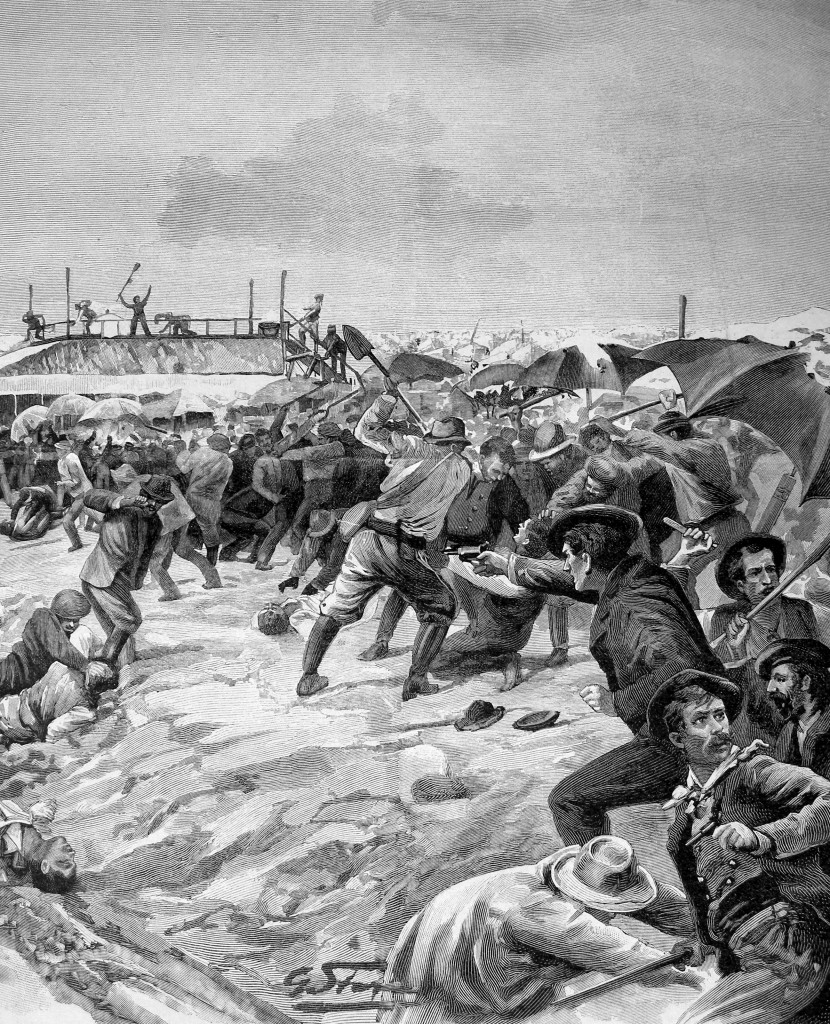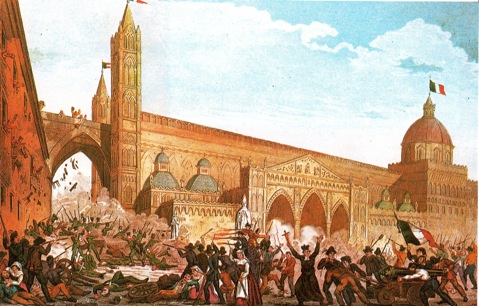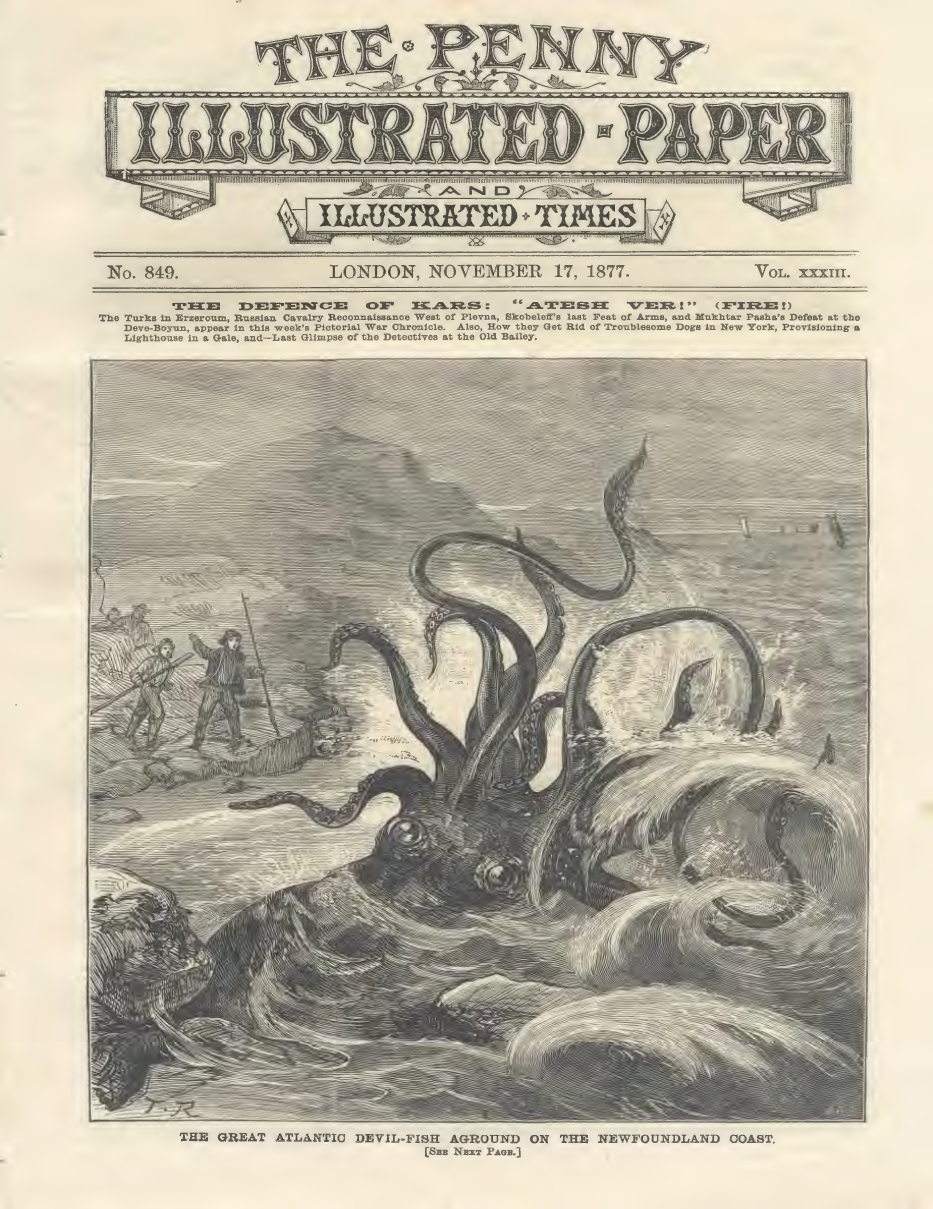|
Massacre Of Italians At Aigues-Mortes
The Massacre of the Italians at Aigues-Mortes was a series of events on 16 and 17 August 1893, in Aigues-Mortes, France, which resulted in the deaths of immigrant Italian workers of the ''Compagnie des Salins du Midi'', at the hands of French villagers and labourers. Estimates range from the official number of eight deaths up to 150, according to the Italian press of the time. Those killed were victims of lynchings, beatings with clubs, drowning and rifle shot. There were also many non-fatal injuries. The massacre was not the first attack by French workers on poor Italian immigrant labourers that were prepared to work at cut-rate wages.Seton-Watson, ''Italy from liberalism to fascism'', pp. 161-62 When the news reached Italy anti-French riots erupted in the country. The case was also one of the greatest legal scandals of the time, since no convictions were ever made. Description of the events In the summer of 1893, the ''Compagnie des Salins du Midi'' began to recruit workers t ... [...More Info...] [...Related Items...] OR: [Wikipedia] [Google] [Baidu] |
Aigues-Mortes
Aigues-Mortes (; oc, Aigas Mòrtas) is a commune in the Gard department in the Occitania region of southern France. The medieval city walls surrounding the city are well preserved. Situated on the junction of the Canal du Rhône à Sète and the Chenal Maritime to Le Grau-du-Roi, the town is a transit center for canal craft and Dutch barges. Toponymy The name "Aigues-Mortes" was attested in 1248 in the Latinized form ', which means "dead water", or "stagnant water". The name comes from the marshes and ponds that surround the village (which has never had potable water). The inhabitants of the commune are known as ''Aigues-Mortais'' or ''Aigues-Mortaises''. The Occitan ' is equivalent to toponymic types in the Morteau Oil dialect cf. Morteau (Doubs): ''mortua Aqua'' (1105, VTF521) and Morteaue (Haute-Marne): ''mortua Aqua'' (1163, VTF521). in French means "pond of the King". In Occitan, ' means "pond with extension". History Antiquity The Roman general Gaius Mari ... [...More Info...] [...Related Items...] OR: [Wikipedia] [Google] [Baidu] |
Alzano Lombardo
Alzano Lombardo (Bergamasque: ) is a in the province of Bergamo, Lombardy, northern Italy. Alzano received the honorary title of city with a presidential decree of 11 March 1991. It is home to the San Martino Museum of Religious Art and the Basilica of San Martino The Basilica of San Martino is a church in piazza Italia at the junction of via Fantoni and via Roma in the historic centre of the north Italian town of Alzano Lombardo. Dedicated to Martin of Tours, it was promoted to the status of a minor ba .... References Cities and towns in Lombardy {{Bergamo-geo-stub ... [...More Info...] [...Related Items...] OR: [Wikipedia] [Google] [Baidu] |
Francesco Crispi
Francesco Crispi (4 October 1818 – 11 August 1901) was an Italian patriot and statesman. He was among the main protagonists of the Risorgimento, a close friend and supporter of Giuseppe Mazzini and Giuseppe Garibaldi, and one of the architects of Italian unification in 1860.Nation-building in 19th-century Italy: the case of Francesco Crispi Christopher Duggan, History Today, 1 February 2002 Crispi served as for six years, from 1887 to 1891, and again from 1893 to 1896, and was the first Prime Minister from Southern Italy. Crispi ... [...More Info...] [...Related Items...] OR: [Wikipedia] [Google] [Baidu] |
Il Messaggero
''Il Messaggero'' (Italian : "The Messenger") is an Italian newspaper based in Rome, Italy. It has been in circulation since 1878. History and profile ''Il Messaggero'' was founded in December 1878. On 1 January 1879, the first issue of ''Il Messaggero'' was published, under the management of Luigi Cesana. The paper aimed at being the newspaper of newspapers and at providing its readers with all opinions and all events. The first four copies of the paper were delivered as free samples to the subscribers of the newspaper, '' Il Fanfulla''. One of the early editors-in-chief of ''Il Messaggero'' was Alberto Cianca who resigned from the post due to political reasons. Since its inception, ''Il Messaggero'' has been owned by different companies. One of the former owners is Montedison through the Ferruzzi Group. In 1996 the paper was acquired by Francesco Gaetano Caltagirone. He founded the Caltagirone Editore in 1999. The company is the majority owner of the paper which has its 90%. ... [...More Info...] [...Related Items...] OR: [Wikipedia] [Google] [Baidu] |
Saint-Laurent-du-Pont
Saint-Laurent-du-Pont () is a commune in the Isère department in southeastern France. It was the site of the Club Cinq-Sept fire, which killed 146, in 1970. Population Economy There is a large cement works at Saint-Laurent-du-Pont, unusually inside a national park. Twin towns — sister cities Saint-Laurent-du-Pont is twinned with: * Herdorf, Germany (1984) * Berbenno, Italy (1985) See also *Communes of the Isère department The following is a list of the 512 Communes of France, communes in the French Departments of France, department of Isère. The communes cooperate in the following Communes of France#Intercommunality, intercommunalities (as of 2020): References Communes of Isère[...More Info...] [...Related Items...] OR: [Wikipedia] [Google] [Baidu] |
Angoulême
Angoulême (; Poitevin-Saintongeais: ''Engoulaeme''; oc, Engoleime) is a communes of France, commune, the Prefectures of France, prefecture of the Charente Departments of France, department, in the Nouvelle-Aquitaine region of southwestern France. The inhabitants of the commune are known as ''Angoumoisins'' or ''Angoumoisines''. Located on a plateau overlooking a meander of the river Charente (river), Charente, the city is nicknamed the "balcony of the southwest". The city proper's population is a little less than 42,000 but it is the centre of an urban area of 110,000 people extending more than from east to west. Formerly the capital of Angoumois in the Ancien Régime, Angoulême was a fortified town for a long time, and was highly coveted due to its position at the centre of many roads important to communication, so therefore it suffered many sieges. From its tumultuous past, the city, perched on a rocky spur, inherited a large historical, religious, and urban heritage whic ... [...More Info...] [...Related Items...] OR: [Wikipedia] [Google] [Baidu] |
The Times
''The Times'' is a British daily national newspaper based in London. It began in 1785 under the title ''The Daily Universal Register'', adopting its current name on 1 January 1788. ''The Times'' and its sister paper ''The Sunday Times'' (founded in 1821) are published by Times Newspapers, since 1981 a subsidiary of News UK, in turn wholly owned by News Corp. ''The Times'' and ''The Sunday Times'', which do not share editorial staff, were founded independently and have only had common ownership since 1966. In general, the political position of ''The Times'' is considered to be centre-right. ''The Times'' is the first newspaper to have borne that name, lending it to numerous other papers around the world, such as ''The Times of India'', ''The New York Times'', and more recently, digital-first publications such as TheTimesBlog.com (Since 2017). In countries where these other titles are popular, the newspaper is often referred to as , or as , although the newspaper is of nationa ... [...More Info...] [...Related Items...] OR: [Wikipedia] [Google] [Baidu] |
Penny Illustrated Paper
The ''Penny Illustrated Paper'' was a cheap ( 1d.) illustrated London weekly newspaper that ran from 1861 to 1913. Premises Illustrated weekly newspapers had been pioneered by the ''Illustrated London News'' (published from 1842, costing fivepence): its imitators included the ''Pictorial Times'' (1843–48), and – after the 1855 repeal of the Stamp Act – the ''Illustrated Times''. With the abolition of paper duty in 1861 it was possible to envisage an even cheaper mass-circulation illustrated weekly. History The first issue, 12 October 1861, announced itself confidently under the masthead "PENNY ILLUSTRATED PAPER: With All the News of the Week": "A new era opens upon the people. In producing a paper for the million, let us plainly say, we want be esteemed the friend of the people ... A new era is opened to us by the Repeal of the Paper Dutie The paper was apparently initially the charge of Ebenezer Farringtonbr>but the wife and sons of the recently deceased Her ... [...More Info...] [...Related Items...] OR: [Wikipedia] [Google] [Baidu] |
The Graphic
''The Graphic'' was a British weekly illustrated newspaper, first published on 4 December 1869 by William Luson Thomas's company Illustrated Newspapers Ltd. Thomas's brother Lewis Samuel Thomas was a co-founder. The premature death of the latter in 1872 "as one of the founders of this newspaper, nd whotook an active interest in its management" left a marked gap in the early history of the publication. It was set up as a rival to the popular ''Illustrated London News''. The influence of ''The Graphic'' within the art world was immense, its many admirers included Vincent van Gogh, and Hubert von Herkomer.Mark Bills, "Thomas, William Luson (1830–1900)", ''Oxford Dictionary of National Biography'', Oxford University Press, 2004 It continued to be published weekly under this title until 23 April 1932 and then changed title to ''The National Graphic'' between 28 April and 14 July 1932; it then ceased publication, after 3,266 issues. From 1890 until 1926, Luson Thomas's company, ... [...More Info...] [...Related Items...] OR: [Wikipedia] [Google] [Baidu] |
New York Times
''The New York Times'' (''the Times'', ''NYT'', or the Gray Lady) is a daily newspaper based in New York City with a worldwide readership reported in 2020 to comprise a declining 840,000 paid print subscribers, and a growing 6 million paid digital media, digital subscribers. It also is a producer of popular podcasts such as ''The Daily (podcast), The Daily''. Founded in 1851 by Henry Jarvis Raymond and George Jones (publisher), George Jones, it was initially published by Raymond, Jones & Company. The ''Times'' has won List of Pulitzer Prizes awarded to The New York Times, 132 Pulitzer Prizes, the most of any newspaper, and has long been regarded as a national "newspaper of record". For print it is ranked List of newspapers by circulation, 18th in the world by circulation and List of newspapers in the United States, 3rd in the U.S. The paper is owned by the New York Times Company, which is Public company, publicly traded. It has been governed by the Sulzberger family since 189 ... [...More Info...] [...Related Items...] OR: [Wikipedia] [Google] [Baidu] |
Le Temps (Paris)
''Le Temps'' (, ''The Times'') was one of Paris's most important daily newspapers from 25 April 1861 to 30 November 1942. It was a serious paper of record. Founded in 1861 by Edmund Chojecki (writing under the pen name "Charles Edmond") and Auguste Nefftzer, ''Le Temps'' was under Nefftzer's direction for ten years, when took his place, and for nearly 45 years directed the newspaper with an iron hand until his death in 1914. He was succeeded by his sons Émile (1914), and Adrien Jr. (1925) and by Louis Mills (1929). Soon after Mills' death in 1931, ''Le Temps'' became a public limited company. Adrien Hébrard and his successors left substantial freedom to the editorial room and the newspaper had the reputation of keeping its journalists for a long time. ''Le Temps'' always remained moderate politically. The early issues of the newspaper reflected Nefftzer's liberal philosophy and had considerable trouble achieving readership. He frequently had to turn to friends in Alsace who w ... [...More Info...] [...Related Items...] OR: [Wikipedia] [Google] [Baidu] |
Palazzo Farnese
Palazzo Farnese () or Farnese Palace is one of the most important High Renaissance List of palaces in Italy#Rome, palaces in Rome. Owned by the Italian Republic, it was given to the French government in 1936 for a period of 99 years, and currently serves as the French embassy in Italy. First designed in 1517 for the House of Farnese, Farnese family, the building expanded in size and conception when Alessandro Farnese became Pope Paul III in 1534, to designs by Antonio da Sangallo the Younger. Its building history involved some of the most prominent Italian architects of the 16th century, including Michelangelo, Jacopo Barozzi da Vignola and Giacomo della Porta. At the end of the 16th century, the important fresco cycle of The Loves of the Gods (Carracci), ''The Loves of the Gods'' in the Farnese Gallery was carried out by the Bolognese painter Annibale Carracci, marking the beginning of two divergent trends in painting during the 17th century, the Roman High Baroque and Clas ... [...More Info...] [...Related Items...] OR: [Wikipedia] [Google] [Baidu] |






.png)
